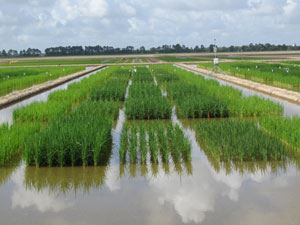AgCenter Researcher Studying Arsenic In Rice
CROWLEY, LA.
Dustin Harrell, LSU AgCenter agronomist at the Rice Research Station
near Crowley, is participating in a multi-state study on arsenic in rice
to determine if levels of the element are higher in different varieties
and to see if varied flooding methods affect arsenic content.
“Can we change the water management practices to alter the uptake and
accumulation of arsenic in rice? That’s what we are investigating,”
Harrell said.
All plants naturally absorb arsenic from the soil, but rice tends to
absorb more because it is growing in a flooded, anaerobic condition, he
said. This makes arsenic more available for uptake by the plant.
The different flooding regimes being used include:
• The traditional drill-seeded, delayed-flood management practice
where a flood is applied after the rice reaches the 3-to-4-leaf stage of
development and is left until two weeks before harvest.
• Intermittent flooding, where the initial flood is held for two to
three weeks and then allowed to evaporate until mud is exposed, followed
by pumping water to a 2-to-4-inch depth.
• Semi-aerobic rice management, where flushing is conducted regularly, but aerobic conditions are allowed to persist.
• Straight head management, where the rice is flooded for 10 days to
two weeks followed by draining until the soil cracks and then followed
by re-flooding until drained for harvest.
The testing is being conducted in all rice-growing states, including
Texas, California, Mississippi, Arkansas, Missouri and Louisiana.

Experimental plots at the Rice Research Station are used to test different fertilizer
rates and the use of different farming practices. LSU AgCenter agronomist Dustin Harrell
said his projects are highly dependent on checkoff funding provided by rice farmers.
Photo by Bruce Schultz
Harrell said the flooding practices that allow the field to drain
typically will require more weed management, which increases herbicide
expenses, increase disease pressure and reduce grain yield.
Varieties being tested are CL151, Cheniere, Presidio and Jupiter – along with hybrids CLXL729 and CLXL745.
All rice samples will be milled at the Rice Research Station and then
sent to a lab for determining inorganic and organic arsenic content,
Harrell said.
The U.S. Food and Drug Administration has recently reported the
results of testing and concluded that no health issues are associated
with arsenic in rice and rice products.
“This study is simply long-term research to allow Louisiana rice
producers to produce the safest, most nutritious rice available for our
customers,” said Steve Linscombe, director of the AgCenter Rice Research
Station.
The project has relied heavily on funding by farmers through the rice
checkoff program and approved by the Louisiana Rice Research Board,
Harrell said.
“This funding source has been extremely important for my research
projects,” he said. “Without this money, the scope of work would be
drastically decreased.”∆